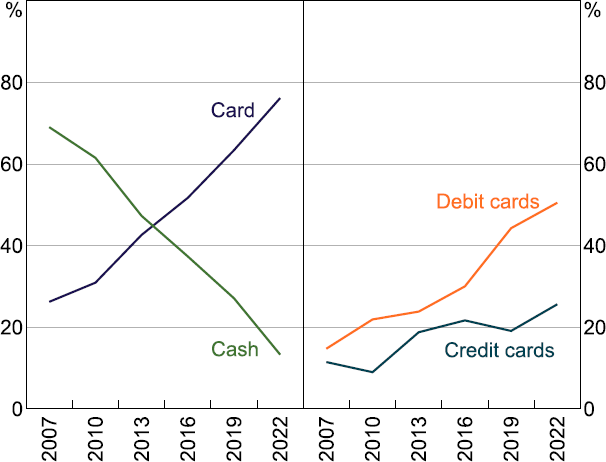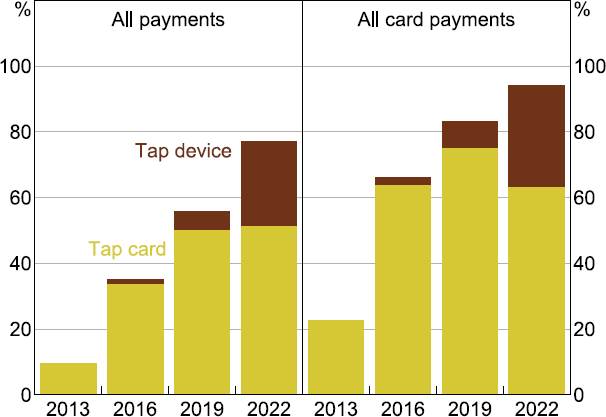RDP 2023-08: The Evolution of Consumer Payments in Australia: Results from the 2022 Consumer Payments Survey Non-technical summary for ‘The Evolution of Consumer Payments in Australia: Results from the 2022 Consumer Payments Survey’
November 2023
The rapid adoption of new payment technologies and the COVID-19 pandemic have changed the way Australians pay. While cash once was king – accounting for 7 in every 10 payments in 2007 – cards have taken over, accounting for a larger share than cash once did. This change was boosted by the introduction of new payment technologies, like ‘tap and go’, and was accelerated by the COVID-19 pandemic.
Every three years since 2007 the Reserve Bank has conducted a Consumer Payments Survey, which provides comprehensive information on how Australians make payments. The survey is a unique source of data on the use of cash and a main source of information on consumers' use of, and attitudes towards, different payment methods. The 2022 Consumer Payments Survey is the first to be conducted since the COVID-19 pandemic and so provides a valuable snapshot of its impact on consumer spending patterns.
The survey shows that Australian consumers increased their use of electronic payment methods instead of cash for day-to-day payments. This long-run shift has been driven by the development of more convenient and seamless payment technology as well as changes in consumer behaviour; this shift was accelerated by the COVID-19 pandemic. Card payments made up the bulk of consumer payments, with debit cards accounting for half of all payments and credit cards another quarter in 2022 (Figure 1 below). Respondents in the 2022 Consumer Payments Survey reported that they were aware of and used a range of other newer payment methods such as PayID, QR code and ‘buy now, pay later’ (BNPL); however, payments made using these methods accounted for only a small share of payments.

Source: RBA calculations, based on data from Colmar Brunton, Ipsos and Roy Morgan Research.
The increase in card usage mirrors the decline in cash usage. Australians halved their share of cash payments by number from 27 per cent in 2019 to 13 per cent in 2022. The demographic groups that traditionally used cash more frequently for payments – such as the elderly, those on lower incomes and those in regional areas – saw the largest declines in cash use.
The survey also shows that contactless payment functionality has changed the way Australians undertake their payments over the past decade. Payments made using contactless functionality, such as tapping a card or waving a mobile device at the payment terminal were used near universally by Australian consumers in 2022, making up around 95 per cent of in-person card transactions and around 80 per cent of all in-person payments. While most contactless payments are made by tapping a physical card, the use of mobile devices has increased sharply from a low base. Contactless mobile payments accounted for nearly one-third of in-person card payments in 2022, up from just 8 per cent in 2019 (Figure 2 below).

Source: RBA calculations, based on data from Colmar Brunton, Ipsos and Roy Morgan Research.
Selected results of the 2022 Consumer Payments Survey were also published in the June 2023 RBA Bulletin (Mulqueeney and Livermore 2023; Nguyen and Watson 2023). The RDP contains a more comprehensive report on the survey results.
References
Mulqueeney J and T Livermore (2023), ‘Cash Use and Attitudes in Australia’, RBA Bulletin, June.
Nguyen T and B Watson (2023), ‘Consumer Payment Behaviour in Australia’, RBA Bulletin, June.